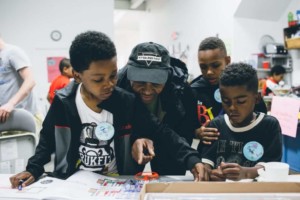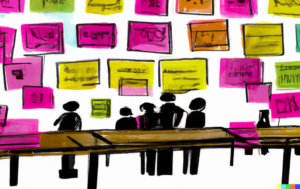20 Moonshots in Education

What’s possible in the next five or 10 years? It’s hard to tell given the exponential rate of technology related change. In the last ten years, we’ve seen the development of smartphones and tablets, Instagram and Snap, ride and room sharing, 3D printing and self-driving vehicles. We’ll see more important advances in the next decade than the last–most will involve artificial intelligence.
A few impact investors like Elon Musk are working on moonshot projects–massively ambitious endeavors that will change where, how well, and how long we live. What big advances are possible in learning and education? Here are 20 ideas we’re tracking (an updated and expanded list from April). They move from expected breakthroughs to more speculative advances.
1. Portable Profiles. Personalized and competency-based learning, in K-12 and for life, will be unlocked by comprehensive learner profiles. We see two complementary developments:
- States will require and support an expanded electronic student record (we call it a data backpack)
- Parents and learners will manage an expanded learner profile and provide portions of it to learning providers.
Profiles are most likely to be made portable using blockchain, a secure and distributed learning ledger.
2. Learning Platforms. Personalized learning is promising but hard to manage manually. Advances in learning platforms will enable individual learning pathways optimizing experiences (see #). They will be easy to configure for specific learning models and school models (see #3).
Two years ago we compiled a list of what teachers and EdLeaders wanted from platforms including:
- Power and track personal learning plans;
- Manage assignments and dynamic grouping;
- Support development of standards-aligned projects;
- Make it easy to combine proprietary, open, district and teacher-developed content;
- Combine formative assessments in a standards-based gradebook (see #5);
- Incorporate social, collaborative, productivity and presentation tools;
- Integrate with other systems and provide single sign-on for lots of apps; and
- Connect students, parents and teachers anywhere on any device.
Next gen platforms will incorporate many of the advances below dynamic scheduling, AR and VR (#9), and better interfaces (#13).
3. Platform Networks. Personalized learning is promising but hard for individual schools to figure out. Schools join voluntary networks like New Tech Network to take advantage of a well-developed school model, platform, and professional learning opportunity. Thousands of schools work with Project Lead The Way (PLTW), a curriculum network that offers courses on a platform with PD. As platforms improve, a growing percentage of schools will join platform networks.

Platform networks hold the potential for a network effect. “We view scale as positive,” said Phil Regier, Dean for Educational Initiatives at Arizona State University (ASU). “We’re going to use scale to get better. Digital learning tends to be scale games. As you get bigger you can make the technology better.”
Speaking on a Gates Foundation podcast, Regier noted the Global Freshman Academy, an online learning partnership with edX as an example of bigger is better. It allows learners to take open classes anytime and only pay after passing a class. “The math class is fantastic. The bigger it gets the better it gets,” said Regier.
Platform networks also make it easier to build urban, rural and thematic microschool networks. Small towns can open small schools supported by networks. Parks, galleries and museums, colleges and companies can host small schools.
4. Literacy. Boosting worldwide literacy–among young and old–might be the biggest and most important moonshot. X Prize is sponsoring a Global Learning Prize (for children) and an Adult Literacy Prize. Add second language acquisition and you have a really big goal (see five part podcast series on language acqusition).
5. Interoperability. It’s great that most U.S. students benefit from multiple forms of instructional feedback every week but it’s frustrating that little of it is easy to combine. The moonshot is interoperability agreements and super gradebooks that automagically combine many different kinds of formative feedback into a mastery tracker and surface it with simple data visualizations.
6. Competency systems. We increasingly live in a ‘show what you know’ world. But shifting away from schools based on age cohorts requires a new assessment infrastructure. Recently released MasteryTrack uses a standard set of assessments to determine mastery. Next-gen systems will help teachers blend of multiple measures including exit tickets, adaptive tests, and performance tasks.
Microcredentials are a digital form of certification that indicate when a person has demonstrated competence in a specific skill set. As a progress tracking and signaling system, micro-credentials are gaining traction in education since they offer a promising approach to personalized, competency-based professional learning. We think sequences of microcredentials will soon take the place of courses and credits for both student and teacher learning.
Competency systems, including microcredentials, (and cheap safe transportation, #11) will power anywhere anytime learning. Portfolios with learning artifacts will become important parts of learner profiles (#1).
7. Regional Shift to Competency. The most interesting regional work in K-12 is the move to proficiency-based learning (also called competency-based) in New England. Great Schools Partnership is facilitating school transformation, state policy shifts to proficiency and recognition of proficiency-based diplomas by all the institutions of higher learning in New England.
Sponsoring state or regional shifts like the work in New England would advance competency-based learning and create demand for competency platforms. Extending opportunities to out of schools (see LRNG network) and adding weighted portable funding would an important development.
8. End of the big test. When every school knows how every student is doing in consistent and reliables ways it will no longer be necessary to stop school for a week in the spring to determine achievement.
Top networks and districts are already there–they combine multiple measures to know how students are doing in each outcome area every day. What they don’t have is a trusted means of communicating student progress to stakeholders including the state.
The first step to ending the big test is a comparability study of leading networks in a state interested in an alternative to the current psychometric drama. A state like Colorado (or district like Denver) could collect and analyze data sets from DSST, KIPP, Strive, and Rocky Mountain Prep. This would demonstrate adequate comparability and reliability of their assessment systems, result in a comparison algorithm between networks, and set the stage for a comparability framework between components (e.g., ST Math, DreamBox, i-Ready).
As networks and districts could demonstrate the reliability and comparability of their assessment systems, they could opt out of part or all of the state testing system like an updated version of the New York Performance Standards Consortium (discussed here). The shift to digital learning and improved ability to analyze big data sets makes it time to end the big end of year test. (This would eventually require an update to federal policy once the infrastructure to do this is in place–but that should be possible because everyone, except the testing vendors, hates the current state of affairs).
9. Virtual Reality & Augmented Reality. Last Christmas, virtual reality (VR) was the breakthrough gadget. With more economical devices and educational content, VR will be a regular and transformative part of every learner’s week. VR will improve career education, language acquisition and global competence. (Listen to why Seth Andrew is excited about VR.)
Augmented reality (AR) with a mixed real-time view of the real world and requested and suggested information will also become prevalent in education with improved interfaces (#5). Imagine field trips that cover the same local route–one week is art and architecture, then demographics and economics, then air and soil quality.
It will be a combination of user interface and powerful learning experiences that make VR and AR moonshot achievements in learning.
10. HR and Talent Development. A top trend in the tech world this year is the 400 startups in HR and talent–most powered by artificial intelligence.
With focused development, educators should expect that it will soon be easier for applicants to find the right job and for schools to find the best possible staff members. AI-powered tools will also improve teacher substitute systems, employee scheduling, HR services, and smarter personalized professional learning.
11. Transportation. With in a decade, forward leaning districts will use self-driving buses and vans (6-12 passenger) and will contract with transport companies for pool cars (think Uber Pool with a background check hauling 3-5 students). This “swarm transportation” approach will unlock personalized schedules and community learning opportunities.
12. Operations. In most states, there won’t be a lot of new money flowing to K-12. The good news is that there are new opportunities for “lean districts” to save money and improve service. Smart tools will be improving meal planning, procurement and staff and student scheduling. All of these improvements will allow schools to invest more in relationships and supports.
13. Human-Computer Interface. Last month, Elon Musk launched Neuralink, which aims to make implants for the human brain that can wirelessly interface with a computer. Mind controlled computers would be a breakthrough in learning as well as business and entertainment. Breakthroughs in user interface–voice, gesture, eye and thought–will be transformative to learning.
14. SEL Measures & Supports. Schools, districts, and networks are rapidly adopting outcome frameworks that embrace mindsets, habits of success, and/or social and emotional learning. There is still an opportunity to better define and measure these important dispositions and skills.
Productive ways to help young people develop self-management and social awareness will be a breakthrough. Biosensors, feedback systems and smart nudges are likely to be part of smart social-emotional learning (SEL) systems.
15. Assistive Tech. The advent of mobile and touch technology was a godsend for youth with special needs, particularly those on the autism spectrum. Advances in UI (#10), translation, text to voice, voice to text and SEL supports (#12) will aid special needs students. The breakthrough could be global access to AT.
16. Motivation. Young (and old) people are motivated by different experiences and drawn to different interests. Learning and behavioral science will unlock secrets of human performance particularly motivational profiles yielding sequences that produce persistence and performance. (See this six-part series on motivating and monitoring performance.)
17. Open Tools. Impact entrepreneurs are creating value by picking a problem, developing some domain expertise, building a dataset and applying smart tools. We call the new formula for making a difference Cause + Code.
What would help more young people get involved in difference making are rich problem statements (like Global Goals or Grand Challenges for Engineering), and open data analysis and machine learning tools.
18. Lifelong Learning. With the rise of the automation economy, lifelong learning is the new imperative–the platforms, incentives and supports that help adults learn employment-relevant skills. Just beyond Coursera, Udemy and EdX are platforms that recommend, personalize and modularize learning. They may leverage relationships (e.g., college alumni), will support multiple providers and have strong links to emerging employment opportunities.
19. Performance Enhancement. Three years ago it was little brain shocks–transcranial direct current stimulation–that were supposed to make you smarter. Two years ago there was a lot of buzz about magic pills–behavioral neuropharmacological enhancement–particularly nootropics that increase productivity and sharpen focus.
More recently mindfulness and meditation have become widely used to help hone performance. Some combination of practices and pills is likely to boost learning and performance.
20. Genomic Editing. CRISPR is a tiny molecular scissors that can alter nucleotides of DNA precisely and simply–and the safety and accuracy are improving fast. At some point soon it will be used to repair defects and boost intelligence. The ethical questions surrounding gene editing, and access to such life altering technologies, are monumental.
What’s on your moonshot list?
For more, see:
- Massive Global Benefit. Waves of Dislocation and Challenge. Time to #AskAboutAI.
- The Technologies Reshaping Life and Livelihood
- How the Platform Revolution is Changing Life and Learning
Stay in-the-know with all things EdTech and innovations in learning by signing up to receive the weekly Smart Update. This post includes mentions of a Getting Smart partner. For a full list of partners, affiliate organizations and all other disclosures please see our Partner page.










Humam
Really good information